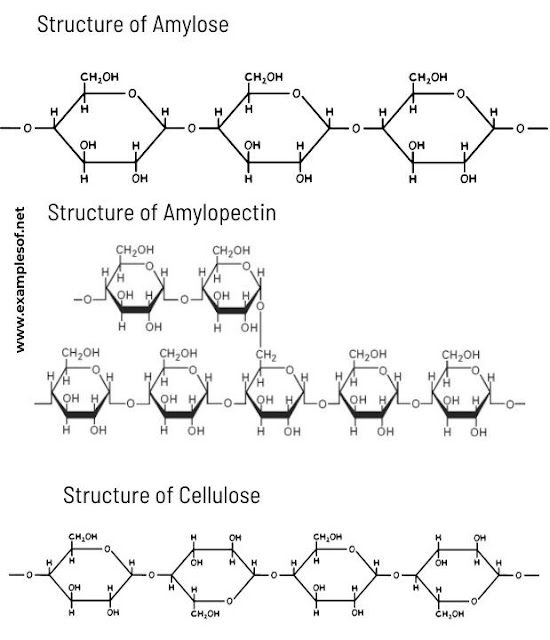Polysaccharides are polymers of ten or more monosaccharide units joined together by glycosidic linkages. These are classified in a number of ways depending upon the type of repeating monosaccharide unit (homo- and hetero-polysaccharides); in the degree of branching, and in the type of glycosidic linkage between the monomeric units.
Examples of some common polysaccharides are starch, glycogen, cellulose and chitin.
Examples of some common polysaccharides
1. Starch: Starch occurs in plants as reserve carbohydrate in tubers, seeds, fruits and roots. It is composed of two homopolysaccharides, amylose (15-20%) and amylopectin (80–85%). Amylose is a linear polymer of α-D-glucose monomers and linked by α(1→ 4) bonds. Amylopectin, on the other hand, consists of glucose units linked by α(1→ 4) glycosidic linkage, like amylose. However, unlike amylose, it is highly branched. Branch points occur every 24 to 30 glucose residues and linkage at the branch points is α(1→ 6) glycosidic. Characteristic blue colour of the starch with iodine is due to amylose. In contrast, amylopectin gives only dull reddish brown colour with iodine.
The enzymes present in saliva (salivary amylase) and pancreatic juice (pancreatic amylase) hydrolyses α(1→ 4) glycosidic linkages of starch therefore digesting it into monomeric glucose residues.

2. Cellulose: Cellulose is the most abundant extracellular structural polysaccharide found in plants. It is also the most abundant of all biomolecules in the biosphere. It is the primary structural component of plant cell wall. Structurally, cellulose is a linear polymer of upto 15000 D-glucose units linked by β(1→ 4) glycosidic bonds. Unlike starch, cellulose cannot be digested by humans as human gut lacks the β(1→ 4) glycosidic bond hydrolysing enzyme known as cellulase. However, cattles and termites can digest cellulose as their gut harbors symbiotic microorganisms that secrete cellulase which hydrolyses and digests cellulose.
3. Glycogen: Glycogen is an extensively branched storage homopolysaccharide found in animals. Similar to amylopectin, it consists of glucose units joined together by α(1→ 4) glycosidic linkage and having α(1→ 6) linkage at branching points. Muscle cells contain glycogen at 1–2 per cent of their dry weight, and liver cells contain up to 10 per cent of their dry weight as glycogen.
4. Chitin: Chitin is a linear polysaccharide of β(1→ 4) linked N-acetyl-D-glucosamine residues. It is the main structural component of the exoskeleton of invertebrates (crustaceans, insects and spiders), and main component of cell walls of most fungi. Chitin and cellulose have similar structures except that OH group at second carbon position of cellulose is replaced by an acetamido group in chitin. Extensive hydrogen bonding of N-acetyl side chains makes chitin tough and insoluble polymer.
5. Peptidoglycan: Peptidoglycan constitutes the rigid component of bacterial cell wall. It is heteropolysaccharide of alternating β(1→ 4) linked N-acetyl-D-glucosamine (NAG) and N-acetyl muramic acid (NAM) residues. The linear polysaccharide chains are cross linked by short peptides attached to N-acetyl muramic acid. Cross linking by peptide welds the polysaccharide chains into a strong sheath that envelops the entire cell and prevents osmotic rupture of the cell. Lysozyme, which is an enzyme present in human tears kills bacteria by hydrolysing the β(1→ 4) glycosidic linkage of peptidoglycan.